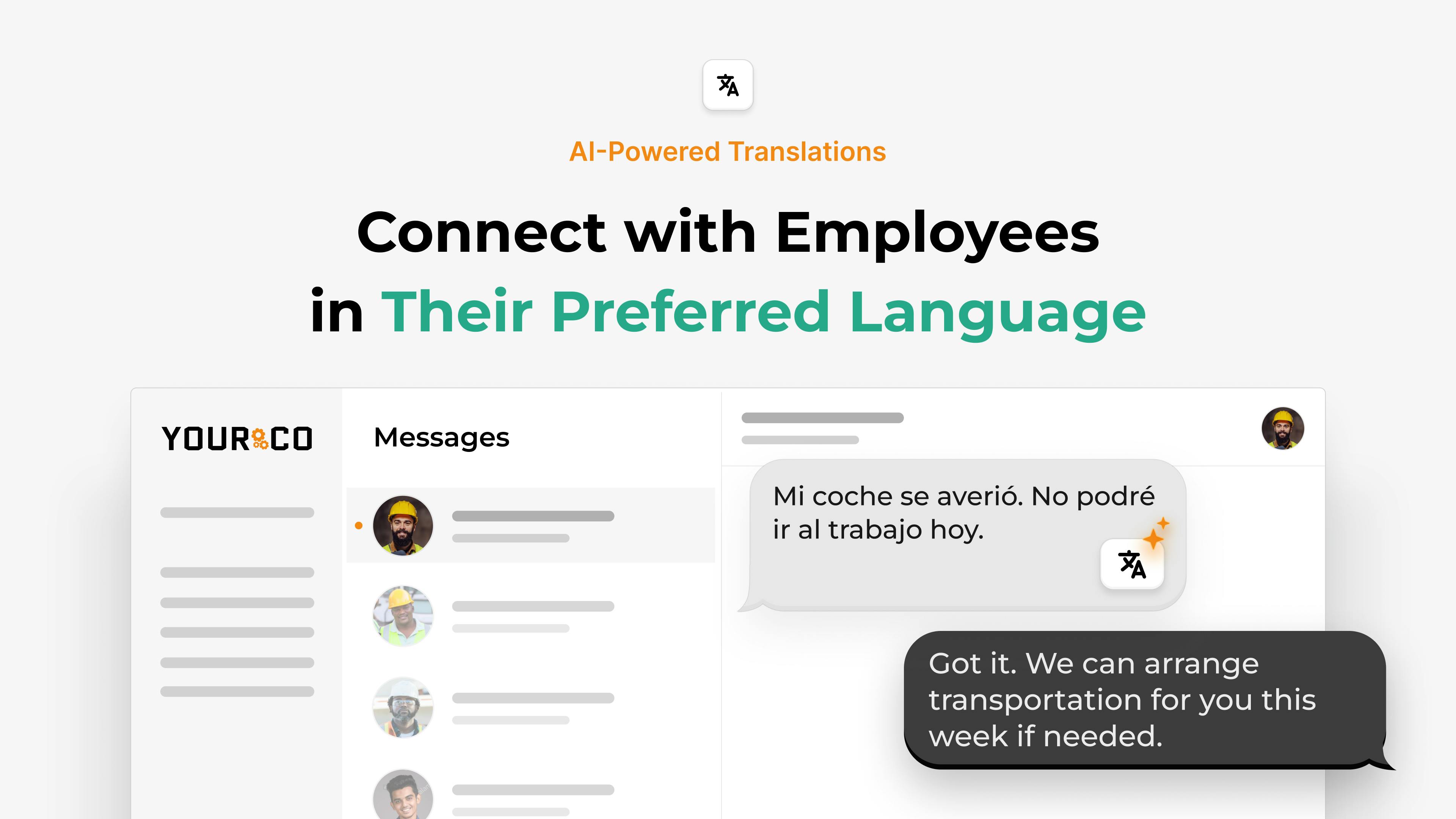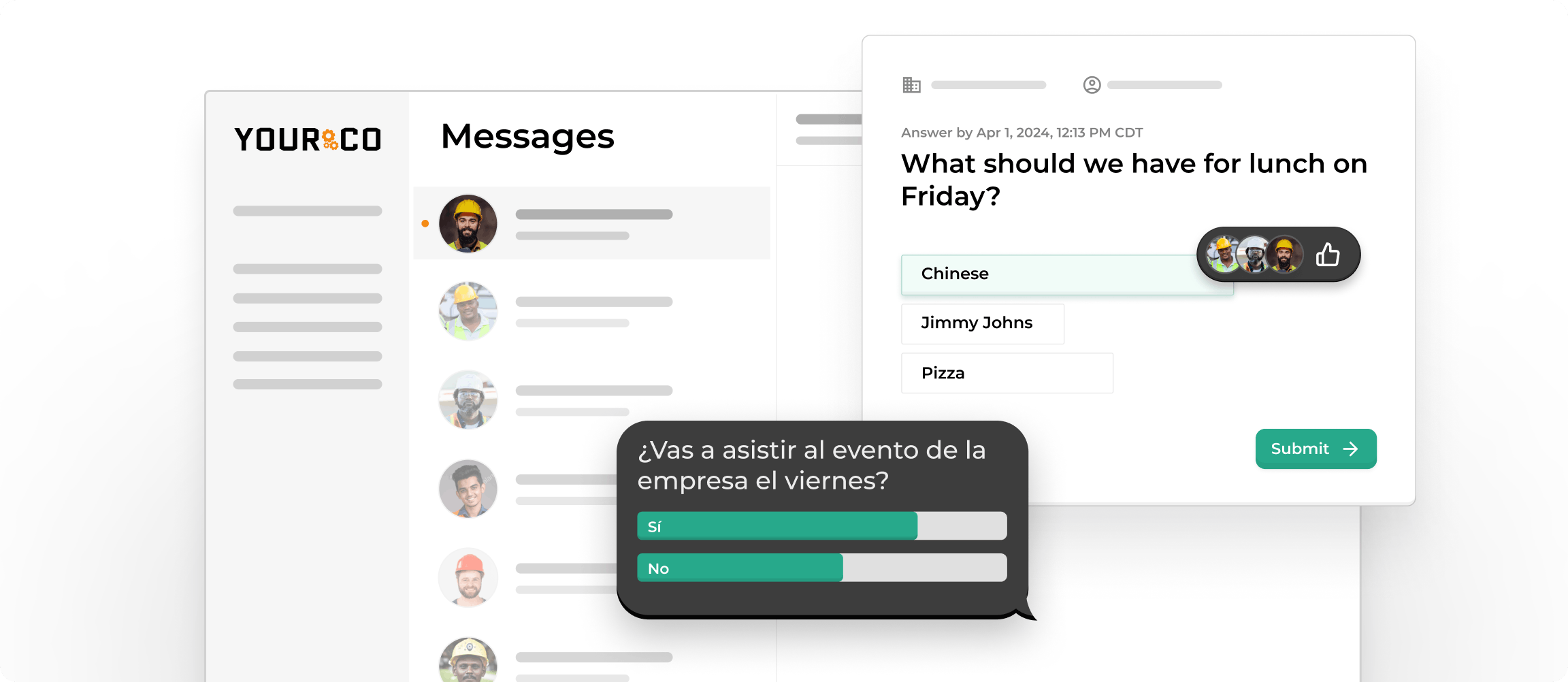Best Onboarding Checklist for Chinese Workers


Chinese-speaking workers keep many factories, warehouses, kitchens, and job sites running. However, most onboarding materials default to English only. When safety manuals, contracts, and daily updates arrive in a language new hires struggle to read, problems pile up fast; mistakes happen, production slows, and workplace injuries increase.
Clear communication makes a difference, and companies that provide effective onboarding in workers’ preferred languages see retention rates climb significantly. Smart onboarding also protects workers, satisfies regulators, and builds the trust your team needs for consistent performance.
This step-by-step checklist shows you how to remove language barriers, meet compliance requirements, and welcome Chinese-speaking employees with confidence from day one.
Lay the Groundwork Before Day One
Setting up the basics before your new hire arrives makes onboarding smoother, safer, and less stressful for everyone. When you prepare clear Chinese-language resources, confirm each worker's language needs, and connect them with the right guide, you prevent confusion and create a welcoming experience from the start.
Prepare Translated Documents and Resources
Start by listing every document the employee will see in their first month, such as employment contracts, safety manuals, wage and benefits forms, equipment checklists, and even workplace signage.
For everyday paperwork, you can move faster with AI tools, then have a professional translator review critical files. Save both Chinese and English versions in your HR system, as you'll need them whenever policies change.
Ask for Language Preferences Early
During pre-boarding, send a short text survey that works on any phone. Ask simple questions like "Which language do you read best at work?" and "Do you prefer updates by text or printed notices?" Rating scales let workers tell you if they only need key terms translated or want everything in Mandarin.
Save those answers in your HR system so safety alerts, wage statements, and daily communications always reach them the right way. A quick preference check keeps you from guessing about every Chinese speaker's comfort with technical English and shows respect right away. Language-specific onboarding speeds up integration, making this small effort pay dividends.
Assign a Bilingual Buddy or Mentor
Choose a partner who speaks both languages well and already knows your safety routines. Look for someone with patience, solid performance, and enough schedule flexibility to check in daily during the first week. Give them a short mentor guide — how to explain unwritten rules, when to step back, and how to escalate questions.
A quick "welcome" call before day one lets the new hire hear a friendly voice and ask early questions, turning that mentor into a trusted resource from the moment they arrive.
Create Comfort and Clarity on the First Day
Your first day plan should put every new Chinese-speaking hire at ease while making sure nothing gets lost in translation. A warm bilingual welcome, a clear safety briefing, a visual tour, and thoughtful introductions create the confidence employees need to start strong.
Send a short, upbeat text the moment the shift starts. A simple "欢迎加入团队!我们很高兴与你一 起合作。如有问题,请随时告诉我。" — "Welcome to the team! We're excited to work with you. Let me know if you have any questions." — shows respect and cuts through first-day nerves.
Personalize the message with the employee's name or work area, and keep it in Simplified Chinese unless you know Traditional is preferred. In Chinese business culture, a sincere, relationship-first greeting signals that the company values trust and harmony, a concept deeply tied to guanxi relationships in workplace culture. SMS works best because every employee can read it instantly, even on basic phones.
Prioritize Safety With Clear Instructions
Next, focus on safety. Every critical rule should appear in Mandarin, backed by pictures or live demonstrations. Your safety briefing should cover:
- PPE requirements and proper usage procedures
- Emergency exit locations and evacuation routes
- Equipment operation protocols and safety shutoffs
- Incident reporting procedures and contact information
Misunderstood safety instructions drive higher accident rates, so ask the new hire to demonstrate a procedure rather than quizzing them publicly. This "show me" method checks comprehension without threatening face, which is a key cultural concern.
Include a quick glossary of high-risk terms: "lockout/tagout 锁定/挂牌," "forklift lane 叉车通道," "chemical shower 化学冲洗站." Post these phrases near the equipment to reinforce learning.
Use Visual Aids During the Facility Walkthrough
During the facility walkthrough, label time clocks, break rooms, restrooms, and lockers with bilingual signs. Snap smartphone photos of software dashboards and add Mandarin call-outs; a laminated printout beside the kiosk saves repeated explanations.
Walk the route twice: the first pass for orientation, the second for questions new hires often hesitate to raise immediately.
Connect With a Bilingual Buddy
Finally, introduce the bilingual buddy and the direct manager together. Begin with light conversation about hometowns or favorite foods — safe topics that encourage dialogue without risk of embarrassment.
The buddy can explain unwritten rules and encourage questions privately. Schedule a brief follow-up chat before the shift ends so the new hire can surface anything still unclear.
By combining language access, visual aids, and culturally aware interaction, you transform day one from overwhelming to empowering and lay the groundwork for safer, more engaged employees.
Build Confidence During the First Week
By the end of the first week, your new hire should understand the job, feel supported, and know exactly what success looks like. Clear training in their preferred language, simple milestones, and regular check-ins make this happen faster.
Start with Bilingual Training
Cover safety procedures, equipment demos, and HR policies in both Mandarin and English. Create handouts with two columns showing both languages, or use reliable tools to maintain formatting.
Having a bilingual trainer helps bridge any cultural gaps that pure translation might miss. Record each session and send the link via text so employees can replay details they missed — especially technical terms that don't translate easily.
Set Clear 30/60/90-Day Expectations
Create one page with three columns: key tasks, resources, and success markers, all written in both languages. This bilingual approach eliminates confusion and respects "saving face," an important Chinese value that discourages public uncertainty.
During the first-week wrap-up, review the plan together, invite questions privately, and agree on the first small win, like completing a quality check alone, to build momentum.
Visual tracking works better than long emails. Post a progress chart in the break room with the employee's initials and color-coded milestones, or share a photo of the chart by text. This lets the whole team celebrate progress without lengthy meetings and gives the new hire a clear view of where they stand.
Conduct Daily Check-ins
Daily check-ins tie everything together. A quick text feels less intimidating than a face-to-face report and works with any shift schedule. Send one message before the shift and one after. Keep it short:
- 早上好!今天有什么需要帮助的吗? / "Good morning! Anything you need help with today?"
- 设备操作顺利吗? / "Did the equipment run smoothly?"
- 今天学到了什么新知识? / "What new thing did you learn today?"
Save responses in your HR system for easy compliance tracking. If you notice a pattern, like repeated safety questions, create a short training clip and share the link in tomorrow's text.
Throughout the week, involve the bilingual buddy you introduced on day one. Let them handle cultural questions and translate feedback you might miss. Structured mentoring has been shown in multiple studies to boost retention and job satisfaction for Chinese staff, reducing early turnover significantly.
With clear training, shared goals, and steady check-ins, you'll see confidence grow, and productivity will follow.
Reinforce and Support During the First 30–90 Days
The first three months determine whether a new hire stays or leaves. By this point, your Chinese-speaking employee knows the basics — now focus on deepening skills, gathering honest feedback, and recognizing wins to build lasting confidence.
Reinforce Training with Refreshers
Treat safety and process training as ongoing, not one-time events. Schedule 10-minute refreshers every two weeks, then conduct a longer skills review at day 60. Short, focused lessons fit easily between shifts and work better when employees feel mentally tired from processing a second language.
Visual reminders work just as well as formal training. Post clear signs near equipment — "戴好安全帽" (Wear your hard hat) or "保持通道畅通" (Keep aisles clear).
Since printed signs get ignored over time, send an SMS reminder before high-risk tasks: "请记得系好安全带 – Remember your harness." Consistent, bilingual reminders reduce errors and lower compliance issues.
Collect Feedback in Chinese
At day 30 and day 90, ask for honest thoughts in whatever language your employee prefers. A quick text survey gets better results than formal meetings. Ask about their most helpful parts of training, what needs improvement, and whether they understand their job goals clearly.
Anonymous links or paper drop boxes help employees speak freely without worrying about losing face, which matters in Chinese workplace culture. Document responses in your HR system and look for patterns — maybe safety videos move too fast or the benefits form only shows English. Share what you changed based on their input. This transparency builds trust and improves retention.
Celebrate Progress
Recognition maintains momentum. Start simple: give a public shout-out during shift change or tape a handwritten note to the break-room board. Add a short message in Mandarin to make it meaningful: "恭喜你顺利完成 30 天培训!继续加油!" (Congrats on finishing your first 30 days—keep going!).
For bigger milestones, consider a team lunch since group celebrations work better than individual awards in Chinese culture. Balance public praise with private encouragement to respect modesty preferences. Thoughtful recognition shows that effort counts, which strengthens engagement in language-inclusive programs.
Focus on Growth After 90 Days
By the three-month mark, your new hire should feel settled. Real engagement starts when you show them a future worth staying for. Now it's time to shift from basic orientation to meaningful growth opportunities, giving employees a clear path forward with bilingual support and a voice in shaping the program.
Create Development Pathways
Career conversations work differently in Chinese workplace culture, where respect for hierarchy shape how people share their goals. Start these discussions with a bilingual document that maps out their career path:
- Current responsibilities and performance expectations
- Skills they want to develop over the next 6-12 months
- Target dates for achieving new competencies
- Who will mentor them through each development stage
Include everything in both English and Simplified Chinese.
Continue Cultural and Language Support
Growth stops when language help disappears too early. Transition from daily check-ins to something more sustainable — maybe weekly touchpoints with their bilingual buddy and monthly skill-building sessions.
Try rotating short cultural exchange activities where Chinese and non-Chinese colleagues share holiday traditions or different approaches to problem-solving. This reinforces the collective values that are important in Chinese workplace culture.
Keep all safety updates, shift changes, and policy announcements bilingual so nobody falls behind on critical information. Long-term language support strategies include:
- Weekly touchpoints with bilingual buddies for ongoing questions
- Monthly skill-building sessions in preferred languages
- Cultural exchange activities between Chinese and non-Chinese colleagues
- Recorded training sessions for review when employees are ready
For long-term development, consider extending stipends for advanced Mandarin literacy or business English training.
Request Process Feedback
A 90-day survey in Simplified Chinese helps you spot problems without putting employees in an awkward position. Ask three focused questions:
- "What part of onboarding helped you most?"
- "Where did you feel confused?"
- "What one change would improve this process?"
Send the survey by text with a link to an anonymous form, then follow up in person if needed.
Document the common themes, share them with managers, and update your materials within a clear timeline so workers see you acting on their suggestions. These feedback loops turn early concerns into improvements that boost retention and performance well beyond day 90.
Build Stronger Teams with Smart Communication
Onboarding Chinese-speaking workers doesn’t just come down to translated documents. It’s about building trust, reducing confusion, and keeping everyone aligned from day one. That requires consistent, clear communication in the language employees understand best — not just at orientation, but throughout their entire journey.
That’s where Yourco makes the difference. With AI-powered translations across 135+ languages and dialects, you can send instant texts that reach every worker, no internet or downloads required. HR managers can deliver welcome messages, safety reminders, training refreshers, and 30/60/90-day surveys directly to any phone. Employees can reply in Mandarin, and Yourco automatically translates their feedback, so nothing gets lost.
Because all messages are securely logged, you also have a compliance-ready record of training, acknowledgments, and surveys. This helps you meet regulatory requirements while strengthening engagement at the same time. Whether you’re hiring one employee or onboarding teams across multiple sites, Yourco makes it simple to scale language-inclusive practices without adding more paperwork to your day.
Try Yourco for free today or schedule a demo and see the difference the right workplace communication solution can make in your company.
FAQs
What's the best way to confirm a Chinese worker's language preference?
Send a simple SMS survey before their first day asking "Which language do you prefer for work messages?" and "Do you read Simplified or Traditional Chinese?" Add their answers to your HR system so all future communications match their preference.
Are machine translation tools reliable for Chinese onboarding?
They work well for basic content, but have a native Chinese speaker review anything important like safety rules or contracts. This catches cultural nuances that machines miss.
How can I verify that Chinese-speaking employees understand safety instructions?
Use the show-and-tell method. After explaining a safety procedure, ask the employee to demonstrate it back to you. This confirms understanding without putting anyone on the spot.
How do I maintain engagement after the first week?
Send daily SMS check-ins in their preferred language and pair them with a bilingual coworker. Regular contact keeps communication flowing and helps catch problems early.
What cultural considerations are most important when onboarding Chinese workers?
Respect workplace hierarchy, give people comfortable ways to ask questions privately, and recognize team achievements alongside individual ones. These values matter in Chinese workplace culture.
How can I ensure compliance documentation works across languages?
While we're not legal professionals, many employers provide contracts and safety documents in both Chinese and English. Store signed copies in a secure system where managers can easily find them when needed.




